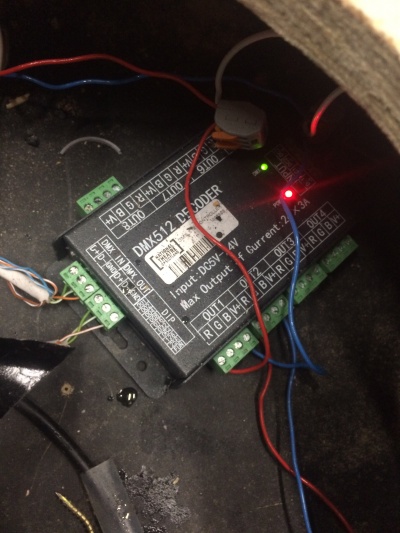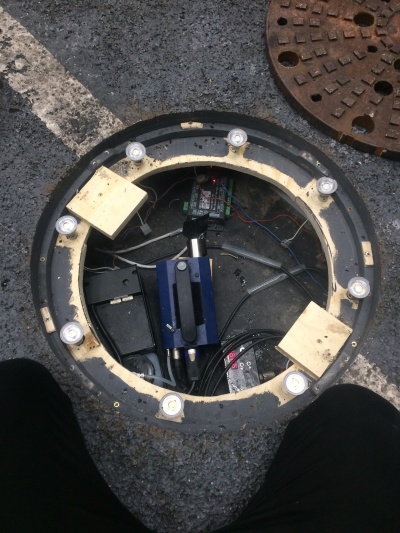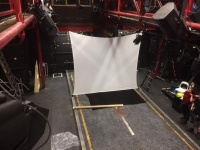London Road
| London Road' | ||||||||||||||||||||||||||||||||||||||||||||
|---|---|---|---|---|---|---|---|---|---|---|---|---|---|---|---|---|---|---|---|---|---|---|---|---|---|---|---|---|---|---|---|---|---|---|---|---|---|---|---|---|---|---|---|---|

| ||||||||||||||||||||||||||||||||||||||||||||
London Road is based on the true story of the Ipswich serial killing murders in 2006. Instead of focusing on the murders and the prosecution of Steven Wright, the musical focuses on the thoughts and feelings from the residents and a group of prostitutes. The play was originally written for the National Theatre in 2011 by Alecky Blythe and the music by Adam Cook.
The play was later developed into a Film, starring Olivia Colman and Tom Hardy.
Stage Management
Hanging Baskets
One of the main challenges I found for the props on London Road was the 12 hanging baskets that had to be made for the final scene. First, we found hanging baskets online that included the lining needed to cut down on costs and then ordered oasis foam for fake flowers to put in the baskets to keep them stable when they were hanging.
It turns out hanging baskets need a lot more fake flowers than you would originally think. We cleared out the RCS props store of fake flowers as well as the props stores of both National Theatre of Scotland and The Tron Theatre.
Once the baskets and foam arrived I got to work arranging the flowers in the baskets. The designer originally asked for the same flowers to be put into each basket but after trying to do this for a while it didn’t look quite right and after emailing the designer we decided that it was best to put the same colour of flowers in each basket.
The designer wanted to have greenery flowing down from the baskets and pointed us towards a pub beside Queen Street Station as a reference for the exact type of basket she wanted. For this we would need a lot more flowers and foliage than we had so I managed to improvise and bend some flowers into a drooping shape and stick them in the foam at an angle that made it look like the hanging greenery that she wanted.
After completing 7 of the 12 baskets needed we found that we would need a lot more fake flowers than what we had. I found that the best place to buy this was the PoundShop on Sauchihall Street just down the street from the Conservatoire. They had the best value for money as they sold realistic small bunches of flowers for a pound each.
After going back and fore to the shop and spending a total of £42 on the flowers we were finally able to create the final baskets. What we found after this was that the metal chains and hook that the baskets hang from would get caught on the stems of the flowers and would lift the foam out of the basket, so we had to find a way to combat this.
We found that the best way to do this was to hang them off the props cage, so the actors could come and pick up their basket without having to fight with the chain and unhook it from whatever flower it had got caught on.
Police Tape Effect
Stage Management designed a system that was simple and effective for a performer to attach police tape from one side of the road to another. The length of the police tape in total was 17metres with a tied loop at one side with a rope loop to atch onto a nail in the tree.
At first we found that the performer was having difficulties with the length of tape, as it could not reach the nail. The length was then altered and a second nail was placed.
For removal of the tape, a performer pulled and broke it. This left enough length to be recycled and added on to make the 17metres.
Film Sequence
At the beginning of the show a projected news report was shown. This was filmed prior to performance in a make shift film studio in R1. Stage Management provided the chairs and other small props, meanwhile a bespoke news table was crafted from workshop.
Stage Management took the lead on the studio floor and in the outdoor film shooting sequences. A continuity log was created to keep note of Slates, Shots and Takes for the editing process. The end footage was a fantastic collaborative achievement from the Production, Musical Theatre and Film degree programs.
Electrics
Practicals
Manhole
The desired effect of the manhole was to have a column of light come up from each of the holes cut out of the cover. Smoke would also come through from under the road and out through the cover too. There were originally two concentric circles of holes but due to lack of budget it was decided that only the outer ring of holes would have a lamp.
The lamps were Osram Parathom LED MR11 3.3W Very Warm White 36 Degree Dimmable lamps. Each one fit into an MR11 low voltage lamp holder.

A secondary ring, in 2 halves, had a hole drilled for each lamp the same spacing as the holes in the cover.
To wire the lamps together I took an old cable with two cores inside and stripped it down to just the two single cores each with their own plastic coating. With the lamp holders positioned in their holes I used 3-way Wagos to wire the lamps in parallel.

To power and control the lamps I used a transformer and a DMX controller. The transformer was plugged into 13a supply that was run under the road. Power then runs to the DMX controller into the V+ and V- terminals. While the lamps are single colour I wired half to one terminal (the first R and V+) and half to another (the second R and V+) as each output has a max of 3A on the controller. Then to program the full ring it is the start address and then +3 for the next channel.
A Power Tiny smoke machine was used for the smoke effect. It was ideal as it runs off a 12v battery and when the top of the unit is sat next to, as opposed to on top of, the battery it fit under the steel deck. It also has a heat up time of 1 second which made it easier to control than using ducting from a larger smoke machine that would have sat outside of the deck. The Power Tiny can be controlled by the button on the handle. Or, as we did, a DMX-it which plugs into the back of the unit and has 5-pin DMX in and out so it could be controlled by the lighting desk. It is only either on or off so was only programmed into cues at 100% or 0%.

Lighting Plan
File:London Road LX rig plan 111117b.pdf
Technical Stage Management
Sooky Kabuki
The Sooky Kabuki proved to be one of the most challenging elements of the show. It was formed of a specially made white cloth that was extremely lightweight and stretchy. It was tensioned by its four corners that were hooked onto electric kabuki releases. The kabuki releases for the two bottom corners were installed into the wooden curbs that ran along the two edges of the road. The two top corner releases were rigged on scaff bars running between the three cat walks.
The first plan was to attach a length of pipe to the underside of the catwalk and attach a sash line to the top left corner of the cloth. The line would be run though the pipe, through a pulley and into a counterweight system. The counterweight would also be attached to a kabuki release that would fire in sync with the cloth being released. The weight dropping would then pull the line and the cloth through the pipe and out of view. This system didn't work as there wasn't enough distance for the weights to fall in order to pull the cloth completely out of view. Even with a double purchase counterweight system it still didn't work.
We then swapped out the length of pipe for a much longer and thicker one that we found form workshop. We then attached a cut in half traffic cone to serve as the sniffer and allow the line and the cloth to be sucked up more easily. The pipe and cone had to be washed in order to keep the cloth as clean as possible. This still didn't solve the issue of the cloths departure, so a very low tech but sensible solution was thought up. Instead of a counterweight system, the line would be fed through the window of the fourth Chandler control booth. A crew member would physically haul the line as quickly as possible in order to suck up the cloth quickly.
The new sniffer was mounted at and angle at the end of the third catwalk so the end of the tube was as close to the booth window as possible. As there was nowhere in the booth to rig any kind of pulley, it was decided that someone would have to feed the line through the door leading into the corridor to another crew member, who would have to run as fast as they could with the line, thus pulling the cloth out of site nice and fast.
With time running out, the problems were still far from over. Whilst practicing the corridor running, it became clear that we would need to cordon off the area to stop passing people from interfering with the cue. First year crew had to keep the area clear whilst the kabuki cue was going on. Also on this practice run, the cloth got caught resulting in the top left eyelet being ripped off. This was fixed by wardrobe and the corners were re enforced.
Then there was the problem of it catching on the underside of the catwalk, this meant that the underside had to be rapped in black cloth to stop this from happing. Each of the corners had cable ties attached which hooked onto the kabuki releases. One of these got caught during the open dress as it was put on the wrong way round.
The cue itself required five people; One to fire the kabuki releases, one to run down the corridor with the line, two to cordon off the corridor and one to be on standby to pull the line through should the runner fall or get stuck.
Hanging Baskets
The hanging baskets used a complex dyneema rope flying system. Each basket was attached at the end of the rope, using a figure of eight knot. The line ran straight up, through a swing cheek pulley which rang horizontally to the gantry. The in-dead was tied to the bar using a clove hitch knot. A carabiner was fixed between the two bars on the gantry so that the rope could easily be clipped in using another figure of eight knot for its out dead and its basket dead. Out deads had to be set through the branches of the trees, or else the lines would get caught and fail to fly in.
One issue when flying the basket lines in was there was no weight on the line. We decided to use fish weights below the pulley, so when the line was unclipped from the bar, it would pull downwards to the in dead.
- In Dead - Clove Hitch (on bar)
- Basket Dead - Figure of 8 knot (matt pink tape)
- Out Dead - Figure of 8 knot (matt orange tape)
Flying Basket Effect - Video
Tree
The designer had requested from the first model box shown a tree which wraps around the pilar and goes to the height of the catwalk with branches coming from the top of it. The challenge was finding the tree, we now had to find a Tree with wide enough dimensions to wrap around the 200mm diameter of the pole in the chandler. The Technical Stage Manager then drew up a drawing of how we would need this tree to look. It would be smoothed at the back in order to allow fixing points onto it to refrain it from falling forwards.
The Tree was dried out for 2 months over summer as this was all sorted months in advance to refrain from moisture still being in the tree and could potentially make it heavier. This took an 8 man lift as it weight 330kg with a shared load of 41kg. We transferred it from the van into the chandler venue once all the steel deck road and flooring had been laid so the tree could sit on top of the flooring. We used a 500kg SWL chain block that was bridled with the poly wrap coming below the catwalk for us to fix the chain block onto. This was a slow process of pushing the tree into place once floating to then attach ratchet straps to ensure it stays in place.
During the Get Out there wasn't equipment available that we previously used to get the tree erected. So we had to do a 5-1 pulley system to allow this to lower to the ground. This was a quick way of thinking without taking the maximum capacity weight of the tree and having anyone around it with the potential of getting hurt.









